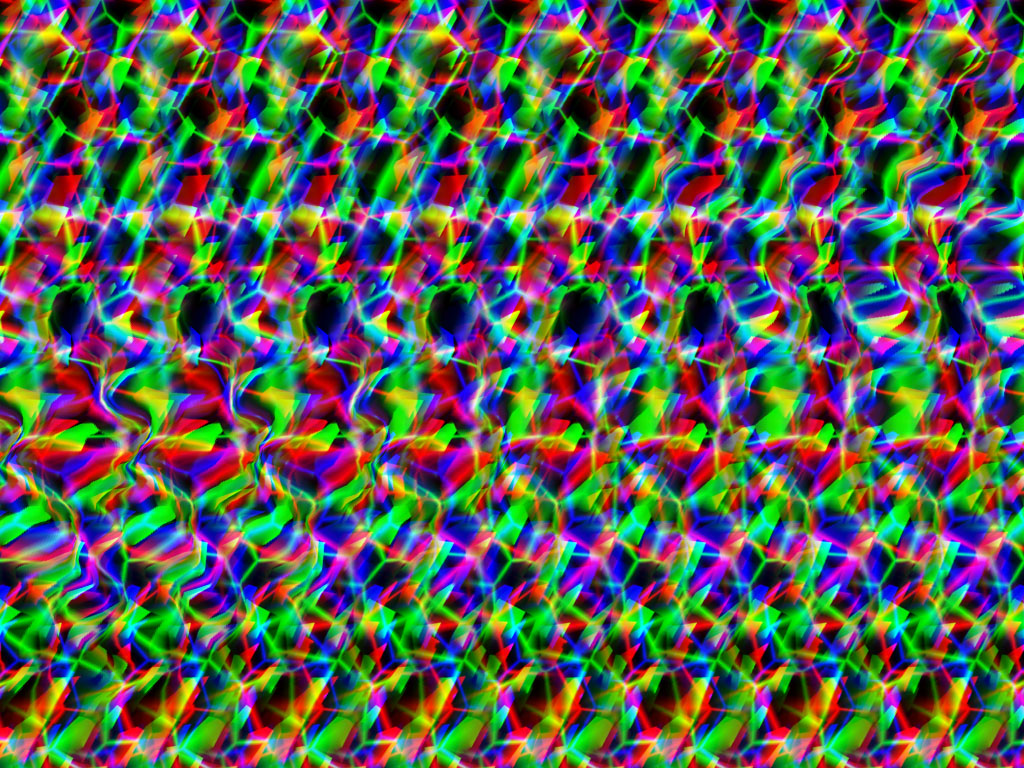

To understand how a stereogram works, you must understand how the eye works LINKLINKLINK. Depth perception depends on having two eyes. Of Course, in order to see a stereogram, a person must have depth perception. When this occurs, it is just as if I was seeing the real object, and I perceive depth. So, if I am in focus behind the plane that the stereogram rests on, and my line of sight of each eye rests on each image of the stereogram, then I have each image in each eye. This point should be over each respective image on the stereogram. The points of this intersection are the images that each eye sees. When I just look at the paper, both eyes focus on the same point, but if I look beyond the paper, then the triangle created by my eyes and my focal point is intersected. In order to do this, I draw two different images on the plane (these are the two images that I would have had in each respective eye had the object really been three dimensional). So, I need to trick my eyes into giving my brain 2 slightly different images. When I combine these two images, my mind is able to use these discrepancies to unconsciously create the phenomena of depth perception.Ī stereogram, however has no depth to it, since it rests on a plane. Each of these images is slightly different since each of my eyes is at a slightly different angle from the object. When I look at an object i get a different image in each eye. This was the birth of the single image random dot stereogram (fig. In 1979 Christopher Tyler discovered that the offset scheme could be applied to a single image. When the two rectangles are viewed together as a stereo pair, the image of the circle appears to float above the background. Next, create a new rectangle identical to the original rectangle, except that the dots within the small shape have been shifted to the left. In this example the small shape is a circle and the selected dots are the dots that fall within the blue circle. Within that rectangle select a group of dots that make up a small shape. First create a rectangle of randomly arranged dots. By using a random dot pattern, Julesz eliminated the depth cues that are inherent in recognizable images.Ĭonsider this example. Read more about the history of stereograms here LINKLINKLINK.

Bela Julesz in 1959 as an experiment to test stereopsis, the ability to see in 3D. THE FIRST RANDOM dot stereogram was invented by Dr. Please contact the Map Library with questions regarding reproduction for publication via e-mail ( ) or by calling 21.That is how Repeated Dot Stereograms work: but instead of fingers, random sequences of dots are used
#EROTIC STEREOGRAM DOWNLOAD#
Instructors are encouraged to download and print the images for classroom or laboratory instructional use. Brief descriptions of each stereogram are available in a separately-published catalog, “University of Illinois Catalog of Stereogram Aerial Photographs.” The catalog is included in the scanned collection. The aerial stereograms in the Committee on Aerial Photography collection show a wide variety of features, both natural and man-made, throughout the United States. By viewing the photo pairs through a stereoscope, the brain can be tricked into seeing or perceiving an impression of heights and depths. Aerial stereograms are created from pairs of aerial photographs that show the same location but from slightly different angles. Source image dates range between 19.Ī stereogram is usually a “3D” picture hidden within a picture they often appear in Sunday newspaper comic strip supplements. The stereograms were created primarily from United States government photography. The University of Illinois at Urbana-Champaign Committee on Aerial Photography began to prepare a set of aerial stereogram photographs to support instruction in aerial photography interpretation in 1959.


 0 kommentar(er)
0 kommentar(er)
